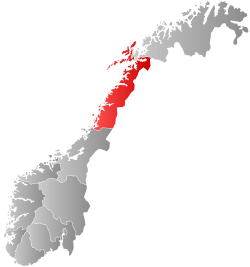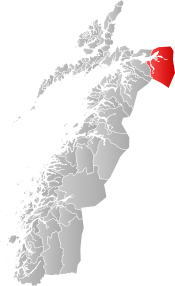Ankenes
Ankenes is a former municipality in Nordland county, Norway. The 2,028-square-kilometre (783 sq mi) municipality existed from 1884 until 1974. It encompassed most of the present-day Narvik Municipality, surrounding of the town of Narvik which was once its own municipality. The administrative centre of Ankenes was the village of Ankenesstrand, situated along the west side of the Beisfjorden, where the Ankenes Church is located.[2][3]
Ankenes herred | |
|---|---|
View of the old Ankenes Herredshus (municipal government building) | |
 Nordland within Norway | |
 Ankenes within Nordland | |
| Coordinates: 68°25′16″N 17°22′11″E | |
| Country | Norway |
| County | Nordland |
| District | Ofoten |
| Established | 1 Jan 1884 |
| Disestablished | 1 Jan 1974 |
| Administrative centre | Ankenesstranda |
| Area | |
| • Total | 2,028 km2 (783 sq mi) |
| *Area at municipal dissolution. | |
| Population (1974) | |
| • Total | 7,022 |
| • Density | 3.5/km2 (9.0/sq mi) |
| Demonym(s) | Ankenesværing[1] |
| Time zone | UTC+01:00 (CET) |
| • Summer (DST) | UTC+02:00 (CEST) |
| ISO 3166 code | NO-1855 |
| Preceded by | Ofoten in 1884 |
| Succeeded by | Narvik in 1974 |
Today, the name Ankenes is often used to refer to the suburban Ankenesstrand area, just outside the town of Narvik. The European route E6 highway is the main thoroughfare through Ankenes and it follows the shoreline of the Ofotfjorden and Beisfjorden and it then crosses the fjord over the 375-metre (1,230 ft) long Beisfjord Bridge where it then reaches the town of Narvik.
History
The old municipality of Ofoten was established on 1 January 1838 (see formannskapsdistrikt). Ofoten Municipality included all of the land surrounding the inner part of the Ofotfjorden, including the Ankenes area. On 1 January 1884, Ofoten Municipality was dissolved and split into two municipalities: Ankenes (population: 1,734) and Evindnæs (population: 2,397). In 1901, the Narvik (population: 3,705) received town status as a kjøpstad. Soon after, on 1 January 1902, the new town of Narvik was separated from Ankenes to form a separate municipality. The split left Ankenes with a population of 3,023. On 1 January 1974, the municipality of Ankenes was merged with the town of Narvik to form a new, larger Narvik Municipality. Prior to the merger, Ankenes had 7,022 inhabitants and Narvik had 12,758.[4]
Government
All municipalities in Norway, including Ankenes, are responsible for primary education (through 10th grade), outpatient health services, senior citizen services, unemployment and other social services, zoning, economic development, and municipal roads. The municipality is governed by a municipal council of elected representatives, which in turn elects a mayor.[5]
Municipal council
The municipal council (Kommunestyre) of Ankenes was made up of 25 representatives that were elected to four year terms. The party breakdown of the final municipal council was as follows:
| Party Name (in Norwegian) | Number of representatives | |
|---|---|---|
| Labour Party (Arbeiderpartiet) | 13 | |
| Conservative Party (Høyre) | 3 | |
| Christian Democratic Party (Kristelig Folkeparti) | 1 | |
| Centre Party (Senterpartiet) | 6 | |
| Socialist People's Party (Sosialistisk Folkeparti) | 1 | |
| Liberal Party (Venstre) | 1 | |
| Total number of members: | 25 | |
| Party Name (in Norwegian) | Number of representatives | |
|---|---|---|
| Labour Party (Arbeiderpartiet) | 14 | |
| Conservative Party (Høyre) | 4 | |
| Centre Party (Senterpartiet) | 3 | |
| Socialist People's Party (Sosialistisk Folkeparti) | 2 | |
| Liberal Party (Venstre) | 2 | |
| Total number of members: | 25 | |
| Party Name (in Norwegian) | Number of representatives | |
|---|---|---|
| Labour Party (Arbeiderpartiet) | 15 | |
| Conservative Party (Høyre) | 4 | |
| Christian Democratic Party (Kristelig Folkeparti) | 1 | |
| Centre Party (Senterpartiet) | 3 | |
| Socialist People's Party (Sosialistisk Folkeparti) | 1 | |
| Liberal Party (Venstre) | 1 | |
| Total number of members: | 25 | |
| Party Name (in Norwegian) | Number of representatives | |
|---|---|---|
| Labour Party (Arbeiderpartiet) | 14 | |
| Conservative Party (Høyre) | 5 | |
| Communist Party (Kommunistiske Parti) | 1 | |
| Christian Democratic Party (Kristelig Folkeparti) | 3 | |
| Centre Party (Senterpartiet) | 2 | |
| Total number of members: | 25 | |
| Party Name (in Norwegian) | Number of representatives | |
|---|---|---|
| Labour Party (Arbeiderpartiet) | 15 | |
| Conservative Party (Høyre) | 3 | |
| Communist Party (Kommunistiske Parti) | 1 | |
| Christian Democratic Party (Kristelig Folkeparti) | 1 | |
| Farmers' Party (Bondepartiet) | 3 | |
| Liberal Party (Venstre) | 2 | |
| Total number of members: | 25 | |
| Party Name (in Norwegian) | Number of representatives | |
|---|---|---|
| Labour Party (Arbeiderpartiet) | 10 | |
| Conservative Party (Høyre) | 3 | |
| Communist Party (Kommunistiske Parti) | 1 | |
| Christian Democratic Party (Kristelig Folkeparti) | 2 | |
| Farmers' Party (Bondepartiet) | 5 | |
| Liberal Party (Venstre) | 3 | |
| Total number of members: | 24 | |
| Party Name (in Norwegian) | Number of representatives | |
|---|---|---|
| Labour Party (Arbeiderpartiet) | 10 | |
| Communist Party (Kommunistiske Parti) | 3 | |
| Christian Democratic Party (Kristelig Folkeparti) | 2 | |
| Farmers' Party (Bondepartiet) | 6 | |
| Liberal Party (Venstre) | 3 | |
| Total number of members: | 24 | |
| Party Name (in Norwegian) | Number of representatives | |
|---|---|---|
| Labour Party (Arbeiderpartiet) | 10 | |
| Communist Party (Kommunistiske Parti) | 4 | |
| Christian Democratic Party (Kristelig Folkeparti) | 3 | |
| Farmers' Party (Bondepartiet) | 4 | |
| Liberal Party (Venstre) | 3 | |
| Total number of members: | 24 | |
| Party Name (in Norwegian) | Number of representatives | |
|---|---|---|
| Labour Party (Arbeiderpartiet) | 13 | |
| Farmers' Party (Bondepartiet) | 6 | |
| Liberal Party (Venstre) | 5 | |
| Total number of members: | 24 | |
Notable residents
- Gunnar Emil Garfors (1900–1979), a Norwegian poet
- Ola Teigen (1937–1970), a politician for the Norwegian Labour Party
- Toralv Kollin Markussen (1895–1973), a politician for the Norwegian Communist Party
References
- "Navn på steder og personer: Innbyggjarnamn" (in Norwegian). Språkrådet.
- Helland, Amund (1908). "Ankenes herred". Norges land og folk: Nordlands amt (in Norwegian). XVIII. Kristiania, Norway: H. Aschehoug & Company. p. 434. Retrieved 2018-09-05.
- Thorsnæs, Geir, ed. (2016-07-06). "Ankenes". Store norske leksikon (in Norwegian). Kunnskapsforlaget. Retrieved 2018-09-05.
- Jukvam, Dag (1999). "Historisk oversikt over endringer i kommune- og fylkesinndelingen" (PDF) (in Norwegian). Statistisk sentralbyrå.
- Hansen, Tore, ed. (2016-05-12). "kommunestyre". Store norske leksikon (in Norwegian). Kunnskapsforlaget. Retrieved 2020-02-02.
- "Kommunevalgene 1972" (PDF) (in Norwegian). Oslo: Statistisk sentralbyrå. 1973. Retrieved 2020-03-18.
- "Kommunevalgene 1967" (PDF) (in Norwegian). Oslo: Statistisk sentralbyrå. 1967. Retrieved 2020-03-18.
- "Kommunevalgene 1963" (PDF) (in Norwegian). Oslo: Statistisk sentralbyrå. 1964. Retrieved 2020-03-18.
- "Kommunevalgene og Ordførervalgene 1959" (PDF) (in Norwegian). Oslo: Statistisk sentralbyrå. 1960. Retrieved 2020-03-18.
- "Kommunevalgene og Ordførervalgene 1955" (PDF) (in Norwegian). Oslo: Statistisk sentralbyrå. 1957. Retrieved 2020-03-18.
- "Kommunevalgene og Ordførervalgene 1951" (PDF) (in Norwegian). Oslo: Statistisk sentralbyrå. 1952. Retrieved 2020-03-18.
- "Kommunevalgene og Ordførervalgene 1947" (PDF) (in Norwegian). Oslo: Statistisk sentralbyrå. 1948. Retrieved 2020-03-18.
- "Kommunevalgene og Ordførervalgene 1945" (PDF) (in Norwegian). Oslo: Statistisk sentralbyrå. 1947. Retrieved 2020-03-18.
- "Kommunevalgene og Ordførervalgene 1937" (PDF) (in Norwegian). Oslo: Statistisk sentralbyrå. 1938. Retrieved 2020-03-18.